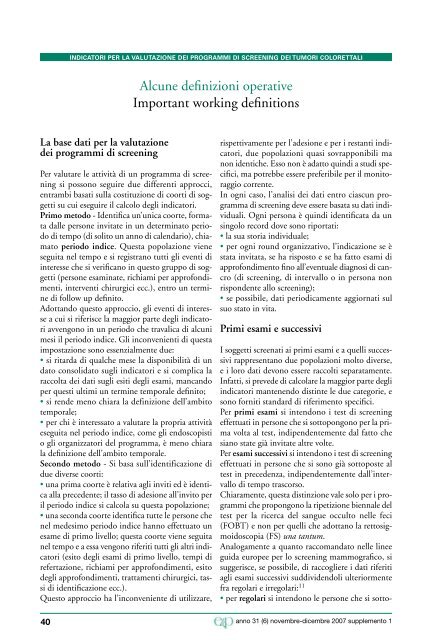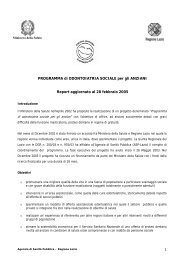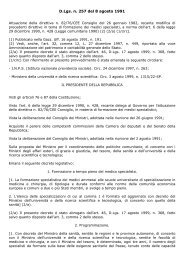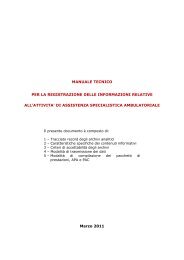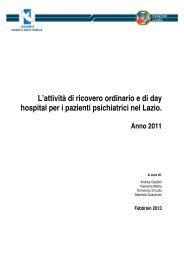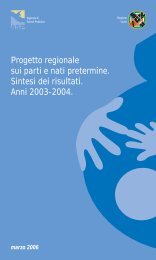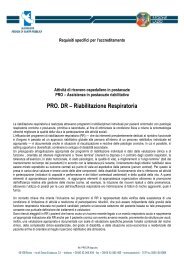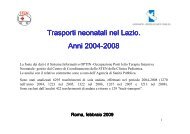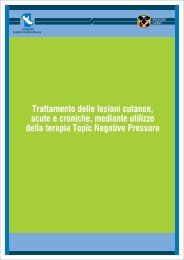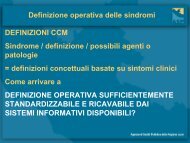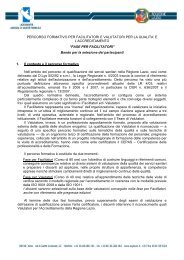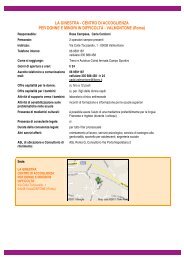Indicatori di qualità per la valutazione dei programmi di screening ...
Indicatori di qualità per la valutazione dei programmi di screening ...
Indicatori di qualità per la valutazione dei programmi di screening ...
You also want an ePaper? Increase the reach of your titles
YUMPU automatically turns print PDFs into web optimized ePapers that Google loves.
INDICATORI PER LA VALUTAZIONE DEI PROGRAMMI DI SCREENING DEI TUMORI COLORETTALI<br />
La base dati <strong>per</strong> <strong>la</strong> <strong>valutazione</strong><br />
<strong>dei</strong> <strong>programmi</strong> <strong>di</strong> <strong>screening</strong><br />
Per valutare le attività <strong>di</strong> un programma <strong>di</strong> <strong>screening</strong><br />
si possono seguire due <strong>di</strong>fferenti approcci,<br />
entrambi basati sul<strong>la</strong> costituzione <strong>di</strong> coorti <strong>di</strong> soggetti<br />
su cui eseguire il calcolo degli in<strong>di</strong>catori.<br />
Primo metodo - Identifica un’unica coorte, formata<br />
dalle <strong>per</strong>sone invitate in un determinato <strong>per</strong>iodo<br />
<strong>di</strong> tempo (<strong>di</strong> solito un anno <strong>di</strong> calendario), chiamato<br />
<strong>per</strong>iodo in<strong>di</strong>ce. Questa popo<strong>la</strong>zione viene<br />
seguita nel tempo e si registrano tutti gli eventi <strong>di</strong><br />
interesse che si verificano in questo gruppo <strong>di</strong> soggetti<br />
(<strong>per</strong>sone esaminate, richiami <strong>per</strong> approfon<strong>di</strong>menti,<br />
interventi chirurgici ecc.), entro un termine<br />
<strong>di</strong> follow up definito.<br />
Adottando questo approccio, gli eventi <strong>di</strong> interesse<br />
a cui si riferisce <strong>la</strong> maggior parte degli in<strong>di</strong>catori<br />
avvengono in un <strong>per</strong>iodo che travalica <strong>di</strong> alcuni<br />
mesi il <strong>per</strong>iodo in<strong>di</strong>ce. Gli inconvenienti <strong>di</strong> questa<br />
impostazione sono essenzialmente due:<br />
• si ritarda <strong>di</strong> qualche mese <strong>la</strong> <strong>di</strong>sponibilità <strong>di</strong> un<br />
dato consolidato sugli in<strong>di</strong>catori e si complica <strong>la</strong><br />
raccolta <strong>dei</strong> dati sugli esiti degli esami, mancando<br />
<strong>per</strong> questi ultimi un termine temporale definito;<br />
• si rende meno chiara <strong>la</strong> definizione dell’ambito<br />
temporale;<br />
• <strong>per</strong> chi è interessato a valutare <strong>la</strong> propria attività<br />
eseguita nel <strong>per</strong>iodo in<strong>di</strong>ce, come gli endoscopisti<br />
o gli organizzatori del programma, è meno chiara<br />
<strong>la</strong> definizione dell’ambito temporale.<br />
Secondo metodo - Si basa sull’identificazione <strong>di</strong><br />
due <strong>di</strong>verse coorti:<br />
• una prima coorte è re<strong>la</strong>tiva agli inviti ed è identica<br />
al<strong>la</strong> precedente; il tasso <strong>di</strong> adesione all’invito <strong>per</strong><br />
il <strong>per</strong>iodo in<strong>di</strong>ce si calco<strong>la</strong> su questa popo<strong>la</strong>zione;<br />
• una seconda coorte identifica tutte le <strong>per</strong>sone che<br />
nel medesimo <strong>per</strong>iodo in<strong>di</strong>ce hanno effettuato un<br />
esame <strong>di</strong> primo livello; questa coorte viene seguita<br />
nel tempo e a essa vengono riferiti tutti gli altri in<strong>di</strong>catori<br />
(esito degli esami <strong>di</strong> primo livello, tempi <strong>di</strong><br />
refertazione, richiami <strong>per</strong> approfon<strong>di</strong>menti, esito<br />
degli approfon<strong>di</strong>menti, trattamenti chirurgici, tassi<br />
<strong>di</strong> identificazione ecc.).<br />
Questo approccio ha l’inconveniente <strong>di</strong> utilizzare,<br />
40<br />
Alcune definizioni o<strong>per</strong>ative<br />
Important working definitions<br />
rispettivamente <strong>per</strong> l’adesione e <strong>per</strong> i restanti in<strong>di</strong>catori,<br />
due popo<strong>la</strong>zioni quasi sovrapponibili ma<br />
non identiche. Esso non è adatto quin<strong>di</strong> a stu<strong>di</strong> specifici,<br />
ma potrebbe essere preferibile <strong>per</strong> il monitoraggio<br />
corrente.<br />
In ogni caso, l’analisi <strong>dei</strong> dati entro ciascun programma<br />
<strong>di</strong> <strong>screening</strong> deve essere basata su dati in<strong>di</strong>viduali.<br />
Ogni <strong>per</strong>sona è quin<strong>di</strong> identificata da un<br />
singolo record dove sono riportati:<br />
• <strong>la</strong> sua storia in<strong>di</strong>viduale;<br />
• <strong>per</strong> ogni round organizzativo, l’in<strong>di</strong>cazione se è<br />
stata invitata, se ha risposto e se ha fatto esami <strong>di</strong><br />
approfon<strong>di</strong>mento fino all’eventuale <strong>di</strong>agnosi <strong>di</strong> cancro<br />
(<strong>di</strong> <strong>screening</strong>, <strong>di</strong> intervallo o in <strong>per</strong>sona non<br />
rispondente allo <strong>screening</strong>);<br />
• se possibile, dati <strong>per</strong>io<strong>di</strong>camente aggiornati sul<br />
suo stato in vita.<br />
Primi esami e successivi<br />
I soggetti screenati ai primi esami e a quelli successivi<br />
rappresentano due popo<strong>la</strong>zioni molto <strong>di</strong>verse,<br />
e i loro dati devono essere raccolti separatamente.<br />
Infatti, si prevede <strong>di</strong> calco<strong>la</strong>re <strong>la</strong> maggior parte degli<br />
in<strong>di</strong>catori mantenendo <strong>di</strong>stinte le due categorie, e<br />
sono forniti standard <strong>di</strong> riferimento specifici.<br />
Per primi esami si intendono i test <strong>di</strong> <strong>screening</strong><br />
effettuati in <strong>per</strong>sone che si sottopongono <strong>per</strong> <strong>la</strong> prima<br />
volta al test, in<strong>di</strong>pendentemente dal fatto che<br />
siano state già invitate altre volte.<br />
Per esami successivi si intendono i test <strong>di</strong> <strong>screening</strong><br />
effettuati in <strong>per</strong>sone che si sono già sottoposte al<br />
test in precedenza, in<strong>di</strong>pendentemente dall’intervallo<br />
<strong>di</strong> tempo trascorso.<br />
Chiaramente, questa <strong>di</strong>stinzione vale solo <strong>per</strong> i <strong>programmi</strong><br />
che propongono <strong>la</strong> ripetizione biennale del<br />
test <strong>per</strong> <strong>la</strong> ricerca del sangue occulto nelle feci<br />
(FOBT) e non <strong>per</strong> quelli che adottano <strong>la</strong> rettosigmoidoscopia<br />
(FS) una tantum.<br />
Analogamente a quanto raccomandato nelle linee<br />
guida europee <strong>per</strong> lo <strong>screening</strong> mammografico, si<br />
suggerisce, se possibile, <strong>di</strong> raccogliere i dati riferiti<br />
agli esami successivi sud<strong>di</strong>videndoli ulteriormente<br />
fra rego<strong>la</strong>ri e irrego<strong>la</strong>ri: 11<br />
• <strong>per</strong> rego<strong>la</strong>ri si intendono le <strong>per</strong>sone che si sotto-<br />
anno 31 (6) novembre-<strong>di</strong>cembre 2007 supplemento 1


